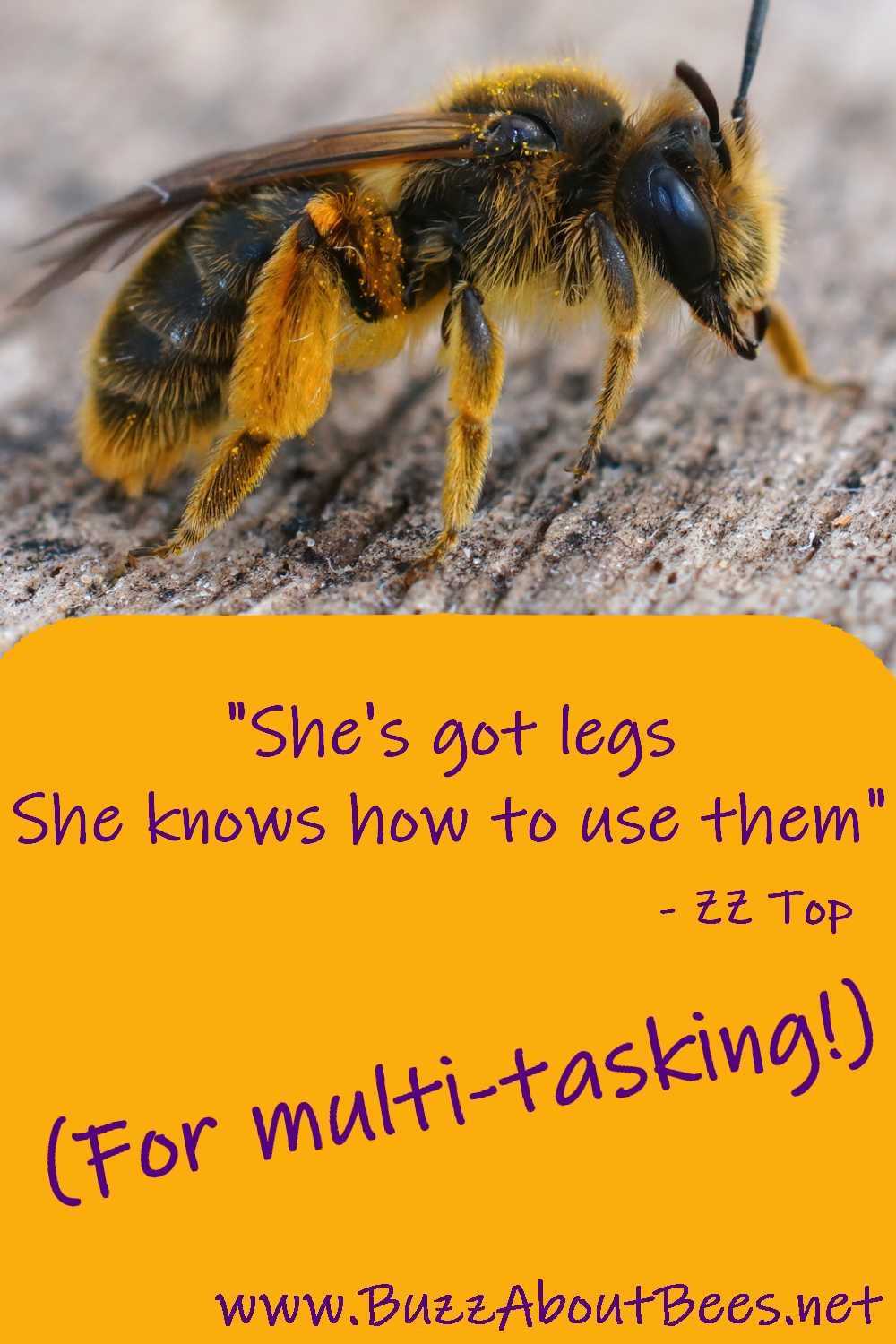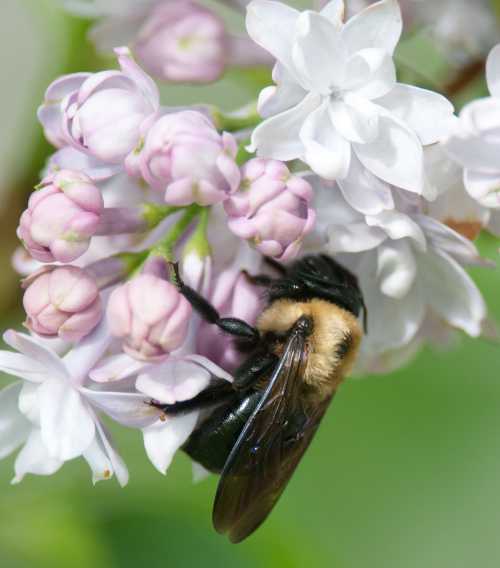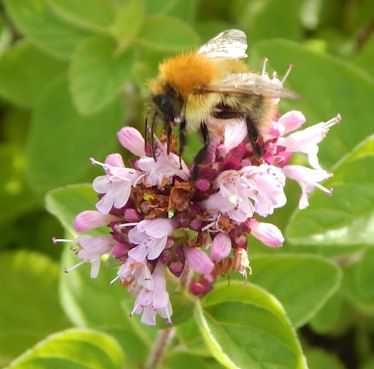How Many Legs Does A Bee Have?
The legs of bees have far more uses than merely walking, and the tasks they perform are vital for the bee's survival.
How many legs does a bee have and what do bees use their legs for?
Bees are insects, and like all insects, bees have six legs - or three pairs:
- two forelegs (to the front of the body)
- two middle legs
- two hind legs.
Why do bees have six legs?
Each pair of legs is uniquely adapted to perform different tasks!
Here's an example:
Whilst foraging, pollen collects on the hairs of the bee's head and body. Using the fore leg, the bee brushes the pollen from the head and body, to the sturdy hind legs. The hind legs of female bees are specifically suited to the purpose of transporting the collected pollen during flight.
It makes sense for bees to carry most of the pollen on their hind legs, where it is out of the way, leaving the front legs unhampered to perform other tasks, such as grabbing flower anthers and grooming their antennae to keep them clean.
At the same time the bees are performing these tasks, the legs may be simultaneously be doing other things, such as picking up vibrations, aiding balance in flight, and more.
What do bees use their legs for?
Here are some of the ways in which the legs of bees perform different tasks. Some of these tasks may surprise you!
1. Walking, 'running'
When they are not flying, bees use all of their legs for moving about on land, flowers and plants, inside the nest or other surfaces.
2. Gathering pollen
As stated, the hind legs on most female bee species are specially adapted to collect and transport pollen (or indeed, other floral substances, such as oils) from the flower back to the nest or hive.
Bees that gather pollen on their hind legs have special features or adaptations in the form of either:
- pollen baskets called corbicula (single) or corbiculae (plural). Pollen baskets are found on female social bees such as honey bees and bumble bees; or
- specially adapted, curled hairs called a floccus, which help to form a kind of pollen brush.
These are found on some female solitary bees, such as those belonging to the mining bee group.
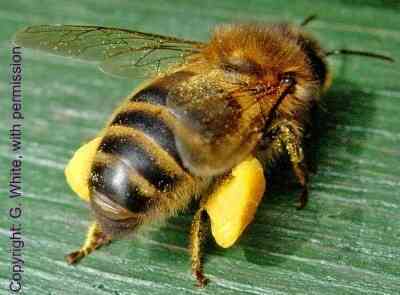 Honey bee with full pollen baskets (corbiculae) on hind legs
Honey bee with full pollen baskets (corbiculae) on hind legs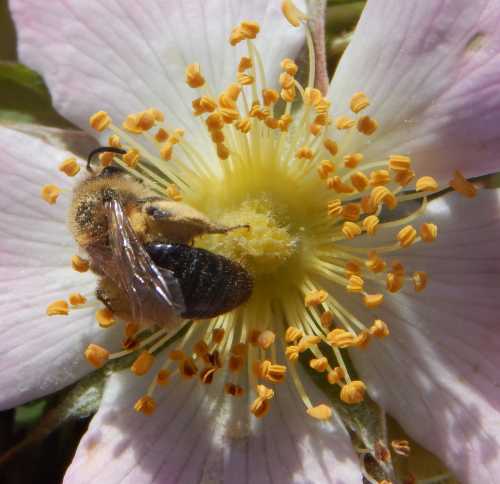 A painted mining bee. This bee collects the pollen in the floccus of each leg. The pollen has a more powdery appearance in this case.
A painted mining bee. This bee collects the pollen in the floccus of each leg. The pollen has a more powdery appearance in this case.3. Tasting
Believe it or not, bees have taste buds on their front feet - this has certainly been proven to be the case with honey bees.
You can read more about this topic on the page how do bees taste.
4. Hearing
Scientists have proven that sound vibrations are picked up by organs (called subgenual organs) in the legs of honey bees. Read more about this on my page Do Bees Have Ears.
5. Grooming - keeping clean
Bees are exposed to all kinds of potentially harmful micro-organisms and bacteria in the environment.
To deal with the problem, bees use their legs for grooming. Their forelegs even feature special 'antennae cleaners'! See my page about antennae.
6. Grabbing
There are times when bees need to grab things. For example, when flower anthers need to be grabbed and shaken to help release pollen.
Bees may also grab and destroy pests, such as Varroa mite.
7. Building
Bees use their legs to construct nest cells. How this task is performed varies by species.
Ground nesting bees often have a 'paint brush' (called a penicillus) on their hind legs (on the basitarsus) which they use to apply a lining to the cell walls of their burrows.
Honey bees and bumble bees use their legs to help them form wax cells.
8. Gathering and Carding
Certain bee species use their legs to help them gather materials for nesting - notably carder bees of various types.
The wool carder bee is a prime example of this. It uses its legs and feet to gather hairs from plants such as lamb's ear.
What are the parts of a bee leg called?
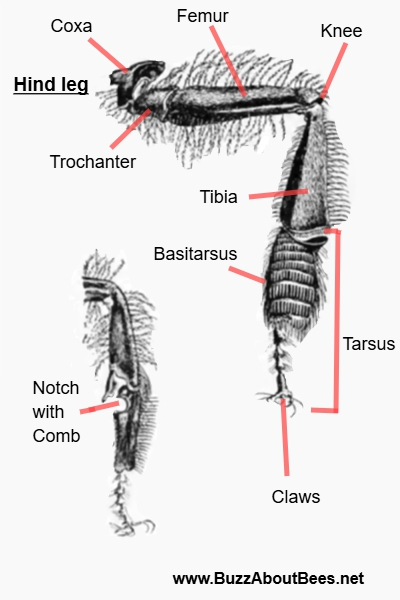
- The coxa. This is the segment closest to the body.
- The trochanter, which connects the coxa and femur.
- The femur (which could be considered the bee's thigh).
- The 'knee' is formed by the joining of the femur to the fourth leg segment which is called the tibia.
- The basitarsus and tarsus (foot).
If a bee loses a leg, can it survive?
Having witnessed a common carder bumble bee flying about and active with one middle leg missing, I personally believe it is possible for a bee to survive if it loses a middle limb, at least for a little time, although it should be remembered that worker bees have short life spans in any case.
However, how long it would be able to survive is unclear. I suspect that if a bee loses a fore leg or hind leg, it will be more severely hampered and may not survive for very long.
Do bees sleep?
Apparently they do, but how do we know?

If you found this page helpful or interesting, I'd really be grateful if you would share it with others - if not this page, perhaps another, such as Gardening For Bees.
Thank you so much :) .
